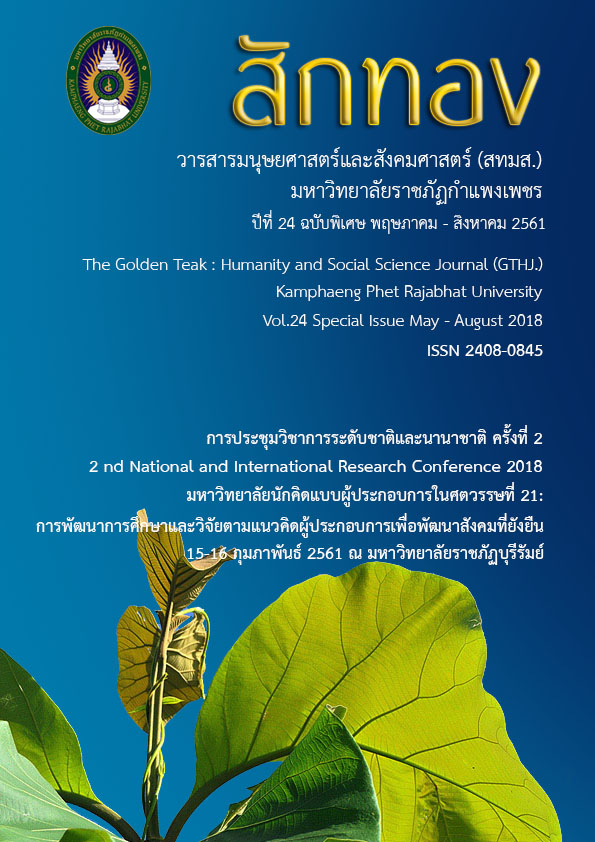Factors Influencing Team Effectiveness: Empirical Study of Undergraduate Student Clubs of 15 Faculties in Kasetsart University, Bangkhen Campus
Main Article Content
Abstract
The objectives of this research were 1. to study the level of team effectiveness in Undergraduate Student Clubs of 15 Faculties in Kasetsart University, Bangkhen Campus, and 2. to study factors (i.e. leadership and cohesion) influencing team effectiveness in Undergraduate Student Clubs of 15 Faculties in Kasetsart University, Bangkhen Campus. The sample size composed of 234 members from the clubs by multi-stage sampling. Data were collected by questionnaires. Statistical methods used for data analysis were percentage, mean, standard deviation, and stepwise multiple regression, at the significance level of 0.05. The results of the research showed that the president or vice president of Undergraduate Student Clubs had high level of leadership and cohesion, and team effectiveness. The leadership and cohesion of the clubs could predict team effectiveness with 71 percent accuracy at the significance level of 0.05, task accomplishment with 54.7 percent accuracy at the significance level of 0.05 and team viability with 69.4 percent accuracy at the significance level of 0.05.
Article Details
บทความที่ได้รับการตีพิมพ์เป็นลิขสิทธิ์ของวารสาร สักทอง : วารสารมนุษยศาสตร์และสังคมศาสตร์ สถาบันวิจัยและพัฒนา มหาวิทยาลับราชภัฏกำแพงเพชร
ข้อคิดเห็นใดๆ ที่ปรากฎในวารสารเป็นวรรณกรรมของผู้เขียนโดยเฉพาะ ซึ่งมหาวิทยาลัยราชภัฏกำแพงเพชรและบรรณาธิการไม่จำเป็นต้องเห็นด้วย
References
Council, Kasetsart University. (2016). 12 Year Vision and Strategic Development Plan of Kasetsart University (2017-2029). [Online]. Available :
http://council.ku.ac.th/wp-content/uploads/file/council_12years.pdf. [2017, September 19].
Forsyth, D.R. (2010). Group Dynamic. (5 th ed). Belmont : Wadsworth, Cengage Learning.
Hackman, J.R. (1987). Handbook of Organizational Behavior. New York : Prentice Hall.
Hansen, R.S. (2006). Benefits and Problems with Student Teams : Suggestions for Improving Team Projects. Journal of Education for Business, 82(1), 11-19.
Hill, S.E.K. (2001). Leadership : Theory and Practice. (2 nd ed.). Thousand Oaks : SAGE.
Kline, T. (1999). Remaking Teams : the revolutionary research-based guide that puts theory into practice. San Francisco : Jossey-Bass Pfeiffer.
Kondalkar, V.G. (2007). Organizational Behaviour. New Delhi : New Age International (P) Ltd.
McShane, L.S. & Glinow, M.A.V. (2010). Organizational Behavior : emerging knowledge and practice for the real world. (5 th ed.). New York : McGraw-Hill.
Mickan, S. & Rodger, S. (2000). Characteristics of Effective Teams : a literature review. Australian Health Review, 23(3), 201-208.
Nega, N. (2010). Understanding the Dynamics of Multidisciplinary Team Effectiveness in the U.S. Environmental Protection Agency Water Programs. Doctor of Philosophy Thesis in Management in Organizational Leadership. University of Phoenix.
Robbins, S.P. & Judge, T. (2013). Organizational Behavior. (15 th ed.). Upper Saddle River : Pearson/Prentice Hall.
Sundstrom, E., De Meuse, K.P. & Futell, D. (1990). Work Teams : Application and Effectiveness. American Psychologist, 45(2), 675-687.
Tekleab, A.G., Quigley, N.R. & Tesluk, P.E. (2009). A Longitudinal Study of Team Conflict, Conflict Management, Cohesion and Team Effectiveness. Group & Organization Management, 34(2), 170-205.
Thornton, P.B. (2004). Leadership : Seeing, Describing, and Pursuing What's Possible. Bloomington : Unlimited Publishing.


